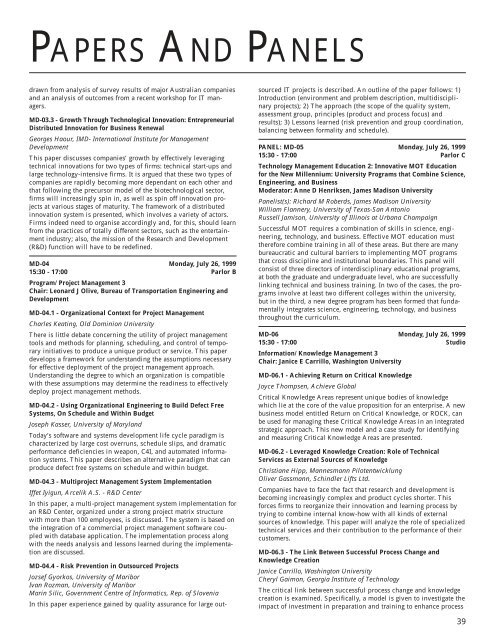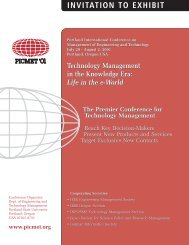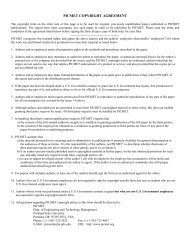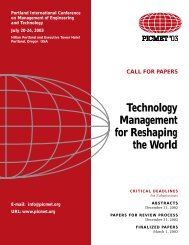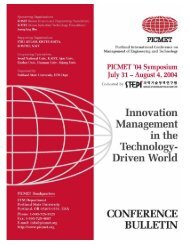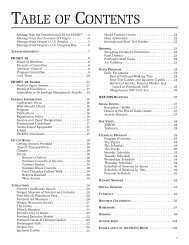Technology & Innovation Management: - PICMET Conference
Technology & Innovation Management: - PICMET Conference
Technology & Innovation Management: - PICMET Conference
Create successful ePaper yourself
Turn your PDF publications into a flip-book with our unique Google optimized e-Paper software.
PAPERS AND PANELS<br />
drawn from analysis of survey results of major Australian companies<br />
and an analysis of outcomes from a recent workshop for IT managers.<br />
MD-03.3 - Growth Through Technological <strong>Innovation</strong>: Entrepreneurial<br />
Distributed <strong>Innovation</strong> for Business Renewal<br />
Georges Haour, IMD- International Institute for <strong>Management</strong><br />
Development<br />
This paper discusses companies’ growth by effectively leveraging<br />
technical innovations for two types of firms: technical start-ups and<br />
large technology-intensive firms. It is argued that these two types of<br />
companies are rapidly becoming more dependant on each other and<br />
that following the precursor model of the biotechnological sector,<br />
firms will increasingly spin in, as well as spin off innovation projects<br />
at various stages of maturity. The framework of a distributed<br />
innovation system is presented, which involves a variety of actors.<br />
Firms indeed need to organise accordingly and, for this, should learn<br />
from the practices of totally different sectors, such as the entertainment<br />
industry; also, the mission of the Research and Development<br />
(R&D) function will have to be redefined.<br />
MD-04 Monday, July 26, 1999<br />
15:30 - 17:00 Parlor B<br />
Program/ Project <strong>Management</strong> 3<br />
Chair: Leonard J Olive, Bureau of Transportation Engineering and<br />
Development<br />
MD-04.1 - Organizational Context for Project <strong>Management</strong><br />
Charles Keating, Old Dominion University<br />
There is little debate concerning the utility of project management<br />
tools and methods for planning, scheduling, and control of temporary<br />
initiatives to produce a unique product or service. This paper<br />
develops a framework for understanding the assumptions necessary<br />
for effective deployment of the project management approach.<br />
Understanding the degree to which an organization is compatible<br />
with these assumptions may determine the readiness to effectively<br />
deploy project management methods.<br />
MD-04.2 - Using Organizational Engineering to Build Defect Free<br />
Systems, On Schedule and Within Budget<br />
Joseph Kasser, University of Maryland<br />
Today’s software and systems development life cycle paradigm is<br />
characterized by large cost overruns, schedule slips, and dramatic<br />
performance deficiencies in weapon, C4I, and automated information<br />
systems. This paper describes an alternative paradigm that can<br />
produce defect free systems on schedule and within budget.<br />
MD-04.3 - Multiproject <strong>Management</strong> System Implementation<br />
Iffet Iyigun, Arcelik A.S. - R&D Center<br />
In this paper, a multi-project management system implementation for<br />
an R&D Center, organized under a strong project matrix structure<br />
with more than 100 employees, is discussed. The system is based on<br />
the integration of a commercial project management software coupled<br />
with database application. The implementation process along<br />
with the needs analysis and lessons learned during the implementation<br />
are discussed.<br />
MD-04.4 - Risk Prevention in Outsourced Projects<br />
Jozsef Gyorkos, University of Maribor<br />
Ivan Rozman, University of Maribor<br />
Marin Silic, Government Centre of Informatics, Rep. of Slovenia<br />
In this paper experience gained by quality assurance for large outsourced<br />
IT projects is described. An outline of the paper follows: 1)<br />
Introduction (environment and problem description, multidisciplinary<br />
projects); 2) The approach (the scope of the quality system,<br />
assessment group, principles (product and process focus) and<br />
results); 3) Lessons learned (risk prevention and group coordination,<br />
balancing between formality and schedule).<br />
PANEL: MD-05 Monday, July 26, 1999<br />
15:30 - 17:00 Parlor C<br />
<strong>Technology</strong> <strong>Management</strong> Education 2: Innovative MOT Education<br />
for the New Millennium: University Programs that Combine Science,<br />
Engineering, and Business<br />
Moderator: Anne D Henriksen, James Madison University<br />
Panelist(s): Richard M Roberds, James Madison University<br />
William Flannery, University of Texas-San Antonio<br />
Russell Jamison, University of Illinois at Urbana Champaign<br />
Successful MOT requires a combination of skills in science, engineering,<br />
technology, and business. Effective MOT education must<br />
therefore combine training in all of these areas. But there are many<br />
bureaucratic and cultural barriers to implementing MOT programs<br />
that cross discipline and institutional boundaries. This panel will<br />
consist of three directors of interdisciplinary educational programs,<br />
at both the graduate and undergraduate level, who are successfully<br />
linking technical and business training. In two of the cases, the programs<br />
involve at least two different colleges within the university,<br />
but in the third, a new degree program has been formed that fundamentally<br />
integrates science, engineering, technology, and business<br />
throughout the curriculum.<br />
MD-06 Monday, July 26, 1999<br />
15:30 - 17:00 Studio<br />
Information/ Knowledge <strong>Management</strong> 3<br />
Chair: Janice E Carrillo, Washington University<br />
MD-06.1 - Achieving Return on Critical Knowledge<br />
Joyce Thompsen, Achieve Global<br />
Critical Knowledge Areas represent unique bodies of knowledge<br />
which lie at the core of the value proposition for an enterprise. A new<br />
business model entitled Return on Critical Knowledge, or ROCK, can<br />
be used for managing these Critical Knowledge Areas in an integrated<br />
strategic approach. This new model and a case study for identifying<br />
and measuring Critical Knowledge Areas are presented.<br />
MD-06.2 - Leveraged Knowledge Creation: Role of Technical<br />
Services as External Sources of Knowledge<br />
Christiane Hipp, Mannesmann Pilotentwicklung<br />
Oliver Gassmann, Schindler Lifts Ltd.<br />
Companies have to face the fact that research and development is<br />
becoming increasingly complex and product cycles shorter. This<br />
forces firms to reorganize their innovation and learning process by<br />
trying to combine internal know-how with all kinds of external<br />
sources of knowledge. This paper will analyze the role of specialized<br />
technical services and their contribution to the performance of their<br />
customers.<br />
MD-06.3 - The Link Between Successful Process Change and<br />
Knowledge Creation<br />
Janice Carrillo, Washington University<br />
Cheryl Gaimon, Georgia Institute of <strong>Technology</strong><br />
The critical link between successful process change and knowledge<br />
creation is examined. Specifically, a model is given to investigate the<br />
impact of investment in preparation and training to enhance process<br />
39


